I am not typically a big fish eater. I suppose I would learn to love it if I were to live in a country where fish is the main protein-food available. My son Mason did this while he lived in Japan going to college. He would tell me about things like a small electric  appliance that looked like a
sideways toaster that was specifically used for grilling your fish fillet for breakfast. But I grew up in a household that used primarily chicken and hamburger as our protein sources. The closest we ever got to fish was the classic fish stick, which was about 20% fish and the rest breading and grease. I do recall having a fresh pan-fried trout that I had caught while on a camping trip with my cousins.
appliance that looked like a
sideways toaster that was specifically used for grilling your fish fillet for breakfast. But I grew up in a household that used primarily chicken and hamburger as our protein sources. The closest we ever got to fish was the classic fish stick, which was about 20% fish and the rest breading and grease. I do recall having a fresh pan-fried trout that I had caught while on a camping trip with my cousins.
Back in those days, fish was still a healthy and clean food source. These days, eating fish is pretty dicey. The oceans have become our trash dump, so not surprisingly the fish that live in this dump are pretty toxic. This problem has only been amplified by the modern practice of fish farming. Much like factory meat production with chicken, pork, and cattle, 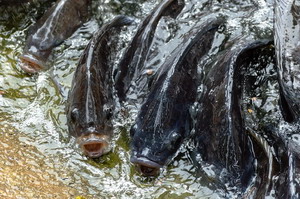 modern fish farming has the same issues. When you cram tons of animals or fish into cramped spaces, you develop problems with disease spread and eliminate the opportunity for normal healthy eating practices. The result is that you have to feed these critters lots of cheap grain-based foods laced with antibiotics. Since the grains are filled with the inflammatory fat linoleic acid,
the critters become filled with the same inflammation-promoting fat. For this reason, I steer clear of factory-raised animals and farmed seafood.
modern fish farming has the same issues. When you cram tons of animals or fish into cramped spaces, you develop problems with disease spread and eliminate the opportunity for normal healthy eating practices. The result is that you have to feed these critters lots of cheap grain-based foods laced with antibiotics. Since the grains are filled with the inflammatory fat linoleic acid,
the critters become filled with the same inflammation-promoting fat. For this reason, I steer clear of factory-raised animals and farmed seafood.
However, all that gloom and doom aside, you can still find some fairly clean wild-caught fish that are healthy to eat. Wild-caught Alaska salmon is one such fish. The levels of mercury, cadmium, and plastics are still low, and they have not been fed a bunch of grain. I was cruising Costco the other day when I found they had a nice load of wild-caught sockeye salmon fillets 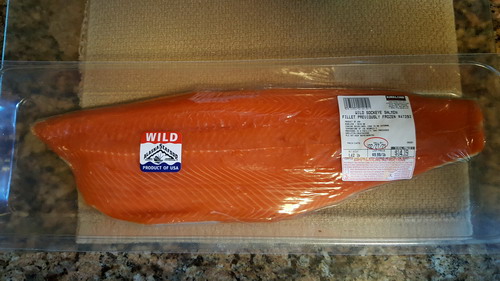 for only $9.98 a pound. That is a great price these days for wild-caught fish. My thought was “How can I capitalize on this sale?” My freezer was already full of all my experimental ice cream samples. I thought of smoking the fish, but then I went to taking that a step further and making a jerky out of it. I had experienced dried fish from the Asian market
as an addition to soup, but I did not know if you could make an actual jerky out of fish. Well, a couple of clicks on youtube showed me that fish jerky was an actual thing, so now all I had to do was create a recipe that did not use the wheat and sugar-containing ingredients those recipes used.
for only $9.98 a pound. That is a great price these days for wild-caught fish. My thought was “How can I capitalize on this sale?” My freezer was already full of all my experimental ice cream samples. I thought of smoking the fish, but then I went to taking that a step further and making a jerky out of it. I had experienced dried fish from the Asian market
as an addition to soup, but I did not know if you could make an actual jerky out of fish. Well, a couple of clicks on youtube showed me that fish jerky was an actual thing, so now all I had to do was create a recipe that did not use the wheat and sugar-containing ingredients those recipes used.
After checking out several recipes, I chose a simple soy sauce, brown sugar, and black pepper marinade for the fish to make into something that I would eat. I used a multigrain gluten-free soy sauce made from  soybeans, sorghum, rice, and buckwheat. I also exchanged the brown sugar for allulose and a touch
of molasses.
soybeans, sorghum, rice, and buckwheat. I also exchanged the brown sugar for allulose and a touch
of molasses.
Marinade:
¼ cup Soy sauce – gluten-free
2 tbs. Allulose
1 tsp. Molasses
½ tsp Black Pepper
At this point, some folks may rightfully ask the question, “Should we eat soy?” In general, I would say no as 90% of soy grown in the US is GMO, so we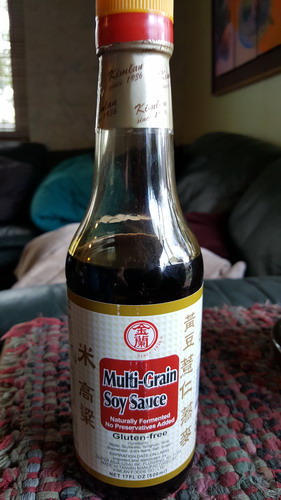 don't really know what effect that is going to have on us. My soy sauce is from Taiwan, so the GMO issue is less likely. The estrogen
hormone-like substances in soy are definitely not good for growing boys but may be helpful for post-menopausal women. The specific situation is everything in health. In either case, the amount of marinade that actually ends up in the fish is minimal, so I was not too concerned.
don't really know what effect that is going to have on us. My soy sauce is from Taiwan, so the GMO issue is less likely. The estrogen
hormone-like substances in soy are definitely not good for growing boys but may be helpful for post-menopausal women. The specific situation is everything in health. In either case, the amount of marinade that actually ends up in the fish is minimal, so I was not too concerned.
Preparing the fish requires a little finesse. You want to cut strips of fish about one-third of an inch wide in the long direction of the fillet. Place the skin side down on your cutting mat. If you have a super sharp knife then you will be able to simply cut the fish into 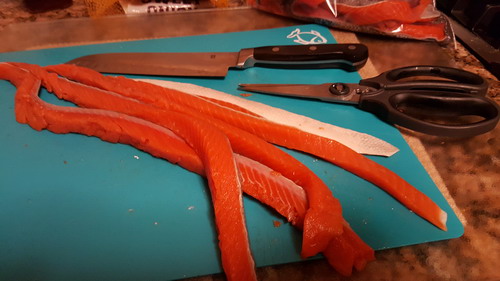 long strips. If your
knife is only an average sharpness then cutting through the skin is a bit difficult. I found that cutting the flesh first down to the skin, then using kitchen shears to cut the skin worked the best for me. You want the skin attached to the flesh, otherwise, the flesh likes to turn into mush. Once
long strips. If your
knife is only an average sharpness then cutting through the skin is a bit difficult. I found that cutting the flesh first down to the skin, then using kitchen shears to cut the skin worked the best for me. You want the skin attached to the flesh, otherwise, the flesh likes to turn into mush. Once 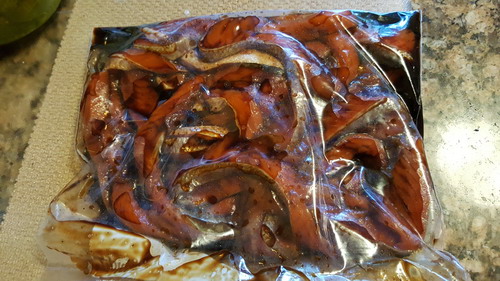 your fish is cut into strips, put the strips into a gallon-size zip-lock
bag and pour in the marinade. Squeeze out all the air and flatten out the bag. Let it sit for 15 minutes then turn it over to distribute the marinade. Do the sit and then flip thing three more times, at which point your fish is ready to dry.
your fish is cut into strips, put the strips into a gallon-size zip-lock
bag and pour in the marinade. Squeeze out all the air and flatten out the bag. Let it sit for 15 minutes then turn it over to distribute the marinade. Do the sit and then flip thing three more times, at which point your fish is ready to dry.
Drying the fish can be done in a food dehydrator or your oven. In both cases, it makes life a lot easier to put the fish on parchment paper laid over the drying rack. Cleanup then becomes a snap. If you are doing this in your oven, take a baking sheet and set your cookie cooling racks on it. Put the parchment 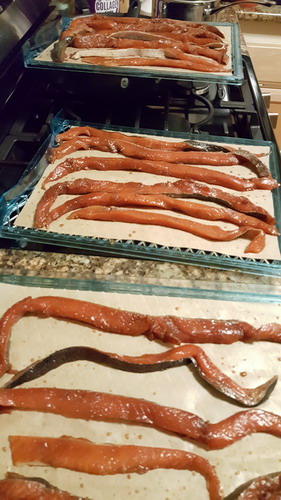 paper over the cooling racks and lay your fish out on the paper so the pieces don't touch each other. Set your oven or dehydrator to 170 degrees and put your trays of fish inside. It should take about 9-12 hours for the fish to turn into delicious jerky. Just peel it off the parchment paper and store it in a ziplock bag in the fridge. It is fine outside the fridge for a day at a time, as the salt and sugar in the marinade both act as preservatives to
inhibit mold. But I would keep it in the fridge for longer-term storage.
paper over the cooling racks and lay your fish out on the paper so the pieces don't touch each other. Set your oven or dehydrator to 170 degrees and put your trays of fish inside. It should take about 9-12 hours for the fish to turn into delicious jerky. Just peel it off the parchment paper and store it in a ziplock bag in the fridge. It is fine outside the fridge for a day at a time, as the salt and sugar in the marinade both act as preservatives to
inhibit mold. But I would keep it in the fridge for longer-term storage.
One fun thing I found with this fish jerky is that the skin of the fish becomes as tough as leather. I found 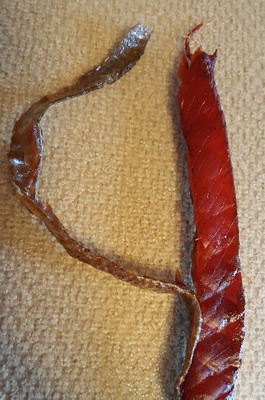 it impossible to eat, though I suspect with an hour or two of chewing I could have gotten it down. I just peel the fish jerky off the skin and enjoy it that way. The fatty layer just under the
skin is where much of the omega 3 oils are that are good for brain health, so I try to get that down the hatch as well.
it impossible to eat, though I suspect with an hour or two of chewing I could have gotten it down. I just peel the fish jerky off the skin and enjoy it that way. The fatty layer just under the
skin is where much of the omega 3 oils are that are good for brain health, so I try to get that down the hatch as well.
Humph, I just had an idea. Another fish that is healthy for our use is sardines. They are on the 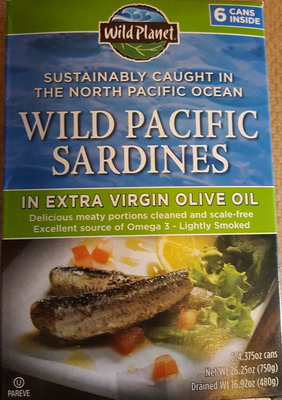 bottom of the feeding chain, meaning that they eat plants and not other fish. That means they do not accumulate toxins in their flesh near as much as predatory fish do. I wonder if I could make some
sort of fish jerky from sardines? To be continued....
bottom of the feeding chain, meaning that they eat plants and not other fish. That means they do not accumulate toxins in their flesh near as much as predatory fish do. I wonder if I could make some
sort of fish jerky from sardines? To be continued....
Take care,
David
Now available, Dr. Dave's Ice Cream Mix - only $10
Just add the mix to a can of coconut milk and blend it on high until it becomes somewhat foamy. Add the flavors or fruit of your choice - chocolate, vanilla, raspberry, root beer, even orange juice concentrate - let your imagination go wild! Put everything into a 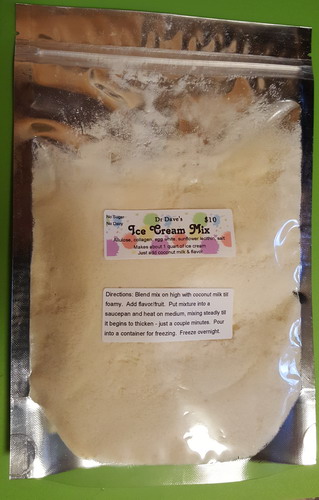 saucepan and gently heat the mixture while stirring constantly until
it just begins to thicken. Take off heat immediately and then pour everything into a container to put into your freezer. In 8 to 12 hours your personal flavor of dairy free sugar free ice cream will be ready to eat! Enjoy! Depending upon what flavors you put into the mix, this recipe makes about one quart of velvety rich ice cream.
saucepan and gently heat the mixture while stirring constantly until
it just begins to thicken. Take off heat immediately and then pour everything into a container to put into your freezer. In 8 to 12 hours your personal flavor of dairy free sugar free ice cream will be ready to eat! Enjoy! Depending upon what flavors you put into the mix, this recipe makes about one quart of velvety rich ice cream.
There are only 15 copies left of the Good Job Journal at the office. These journals counter the constant stream of negative criticism we get from  others and ourselves. Just a minute each day spent jotting down what you did well during
the day helps you to see yourself in a whole new light. We are better than we give ourselves credit for, but we don't see it because we have been taught to ignore the good and focus on the bad. Unfortunately this robs us of the confidence to tackle life with zest and enthusiasm. Get your self transformation tool now for only $10.
others and ourselves. Just a minute each day spent jotting down what you did well during
the day helps you to see yourself in a whole new light. We are better than we give ourselves credit for, but we don't see it because we have been taught to ignore the good and focus on the bad. Unfortunately this robs us of the confidence to tackle life with zest and enthusiasm. Get your self transformation tool now for only $10.
We have received a third batch of  copies of my book The Balanced Life. They are available in the office for $17.99, and they are also
available on Amazon.com
copies of my book The Balanced Life. They are available in the office for $17.99, and they are also
available on Amazon.com
Ellen update:
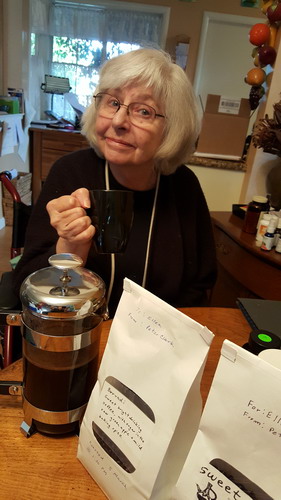
Ellen got a special treat Friday. One of my patients, Peter, has a delicious hobby - he roasts his own coffee beans. He was telling me how different truly fresh roasted beans taste when making coffee. Well Friday he brought in some beans that he had just roasted an hour before his visit. I took them home and ground up some beans and put them in our French press coffee maker for Ellen to try. She
found them to be really good. They were only a couple hours old. When Peter came in for his visit, the whole office smelled like a gourmet coffee shop.

